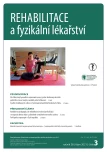Conductive pedagogy as a rehabilitation option for people living with cerebral palsy or central nervous system damage
Authors:
Leszkó D.
Authors‘ workplace:
Military Hospital – State Health Center and the Hungarian Defence Forces –PIC, Budapest, Hungary
; Doctoral School of Semmelweis University, Budapest, Hungary
Published in:
Rehabil. fyz. Lék., 28, 2021, No. 3, pp. 125-131.
Category:
Review Article
doi:
https://doi.org/10.48095/ccrhfl2021125
Overview
A conductor is a professional who helps children with cerebral palsy or adults with central nervous system damage, using a world-famous and effective conductive method. Conductive pedagogy is a pedagogical rehabilitation method dealing with the development of people who are living with brain or nervous system injuries. The goal is to develop an orthofunctional personality, to acquire the ability to live independently, to develop proper coordination and automation of the nervous system. Learning social adaptation, social life, mastering the ways of communication, perception of information from the outside world, promoting one’s own needs. This profession is a named shortage in the labour markets in America, Norway, Sweden, Russia, New Zealand etc. Hundreds of families come to Hungary from abroad because of Pető’s method, but even so, Andráš Pető’s method is little known in Slovakia.
Keywords:
Nervous system – Cerebral palsy – rehabilitation – conductive education – conductors
Sources
- World Health Organization. WHO remains firmly committed to the principles set out in the preamble to the Constitution. [online]. Available from: www.who.int/about/governance/constitution.
- Colver A, Fairhurst C, Pharoah PO. Cerebral palsy. Lancet 2014; 383(9924): 1240–1249. doi: 10.1016/S0140-6736(13)61835-8.
- Klobucká S, Chamutyová K. Štandardné diagnostické a terapeutické postupy v rehabilitácii detskej mozgovej obrny. Bratislava 2007.
- Kudláček M. Svět dětské mozkové obrny. Nahlížení vlastního postižení v průběhu socializace. Praha: Portál 2012. ISBN 978-80-262-0178-6.
- Oskoui M, Coutinho F, Dykeman J et al. An update on the prevalence of cerebral palsy: a systematic review and meta-analysis. Dev Med Child Neurol 2013; 55(6): 509–519. doi: 10.1111/dmcn.12080.
- Faten Hassan Abd El-Azim, Shimaa Mohamed Refaat, Rafik Fayez Attia. Effect of conductive education on motor functions for children with cerebral palsy: systematic review. Med J Cairo University 2018; 86(2): 2115–2121. doi: 10.21608/MJCU.2018.57136.
- Myrhaug HT, Østensjø S, Larun L et al. Intensive training of motor function and functional skills among young children with cerebral palsy: a systematic review and meta-analysis. BMC Pediatr 2014; 14 : 292. doi: 10.1186/s12887-014-0292-5.
- Hári M. A konduktív pedagógia története. Budapest: Mozgássérültek Pető András Nevelőképző és Nevelőintézete 1997.
- Schaffhauser F. A mozgás, a ritmus és az egyensúly alapfogalmai Pető András gondolatrendszerében. 2018. [online]. Available from: http://epa.oszk.hu/01100/01148/00049/pdf/EPA01148_kellek_2018_60_023-038.pdf.
- Barry M. Conductive education in children with cerebral palsy. 2016. [online]. Available from: https://www.acc.co.nz/assets/research/24d3e09133/cerebral-palsy-education-review.pdf.
- Szabó Feketéné É, Gruber M. Opportunities of conductive education in early intervention. Developments in Health Sciences 2018; 1(1): 30–32. doi: 10.1556/2066.1.2018.11.
- Wagner GA. Conductive education. Feasibility study on developing a national curriculum plan for those working in conductive education in New Zealand. Wellington 1994.
- Mohamed SH, Abd El Halim S, Mohamed AG et al. Efficacy of physiotherapy and conductive education in improving motor skills and mental function in children with cerebral palsy. Open Journal of Pediatrics 2020; 10(2): 369–380. doi: 10.4236/ojped.2020.102038.
- Odman P, Oberg B. Effectiveness of intensive training for children with cerebral palsy – a comparison between child and youth rehabilitation and conductive education. J Rehabil Med 2005; 37(4): 263–270. doi: 10.1080/16501970510032622.
- Darrah J, Watkins B, Chen L et al. Conductive education intervention for children with cerebral palsy: an AACPDM evidence report. Dev Med Child Neurol 2007; 46(3): 187–203. doi: 10.1017/s0012162204000337.
- Hári M, Kozma I, Horváth J et al. A konduktív pedagógiai rendszer hatékony működésének alapelvei és gyakorlata. Budapest: Nemzetközi Pető Intézet 1991.
- O’Shea R, Jones M, Lightfoot K. Examining conductive education: linking science, theory, and intervention. Arch Rehabil Res Clin Transl 2020; 2(4): 100077. doi: 10.1016/j.arrct.2020.100077.
- Albers R, Desits K, Filius C et al. Konduktive Förderung. Integration Konduktiver Förderung in das Rehabilitations – und Bildungssystem für Menschen mit Behinderung in Deutschland. Düsseldorf: Fachausschuss Konduktive Förderung 2010.
- Bourke-Taylor H, O’shea R, Gaebler-Spira D. Conductive education: a functional skills program for children with cerebral palsy. Physic Occup Ther Pediatr 2007; 27(1): 45–62.
- Fink A. Praxis der Konduktiven Förderung nach A. Petö. Wien 1998.
- Myrhaug HT, Odgaard-Jensen J, Jahnsen R. The long-term effects of conductive education courses in young children with cerebral palsy: a randomized controlled trial. Dev Neurorehabil 2019; 22(2): 111–119. doi: 0.1080/17518423.2018.1460771.
- Blank R, von Kries R, Hesse S et al. Conductive education for children with cerebral palsy: effects on hand motor functions relevant to activities of daily living. Arch Phys Med Rehabil 2008; 89(2): 251–259. doi: 10.1016/j.apmr.2007.08.138.
- Emerson A, Holroyd F. Conductive education: thirty years on. Disabil Soc 2020; 35(8): 1349–1354. doi: 10.1080/09687599.2019.1685791.
Labels
Physiotherapist, university degree Rehabilitation Sports medicineArticle was published in
Rehabilitation & Physical Medicine

2021 Issue 3
- Hope Awakens with Early Diagnosis of Parkinson's Disease Based on Skin Odor
- Deep stimulation of the globus pallidus improved clinical symptoms in a patient with refractory parkinsonism and genetic mutation
Most read in this issue
- Profile of the profession of occupational therapy in the Czech Republic
- Bilateral, traumatic rupture of the quadriceps tendon – a physiotherapeutic pitfall and case report
- The use of meridian exercises in physiotherapy of non-specific back pain
- Influence of the Träbert current on the autonomic nervous system, evaluated by parameters of time and spectral analysis of heart rate variability in healthy probands
